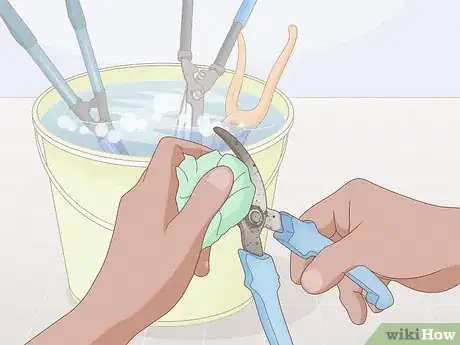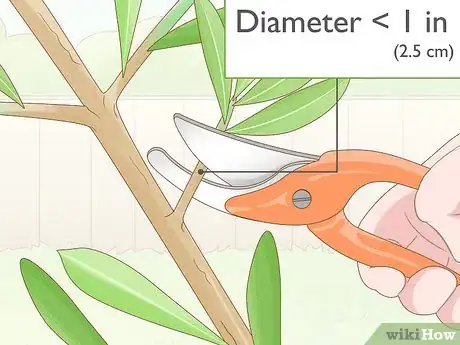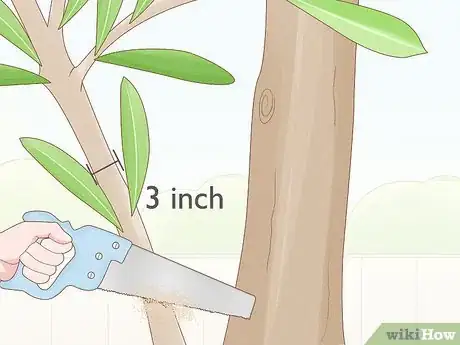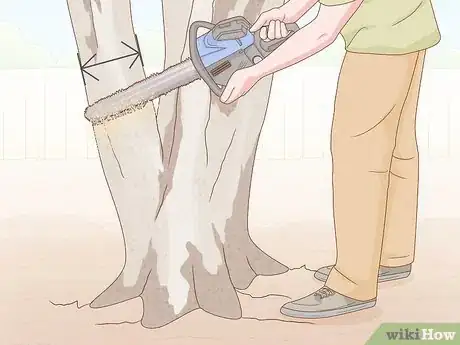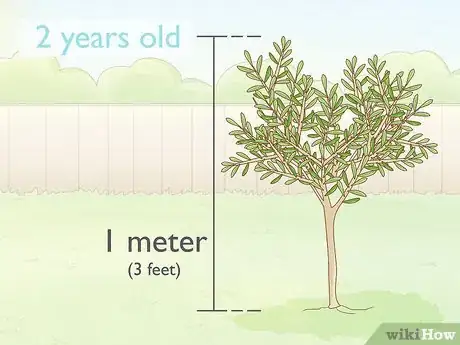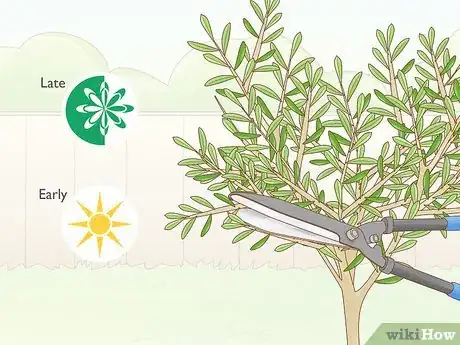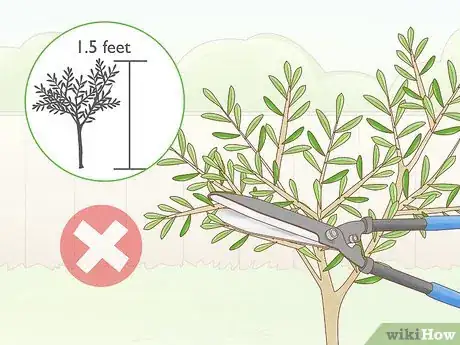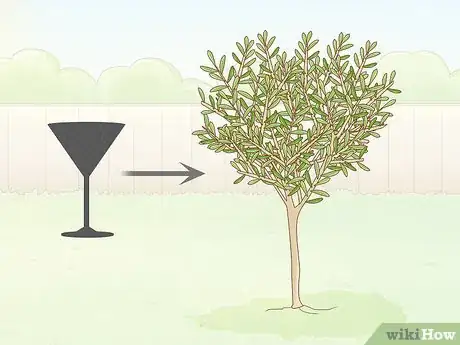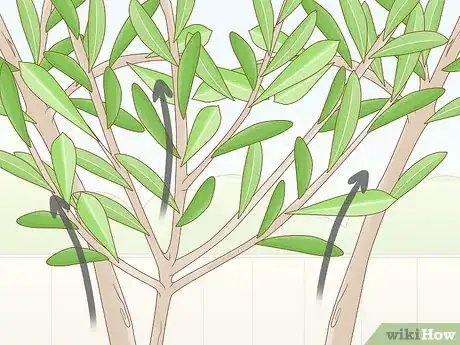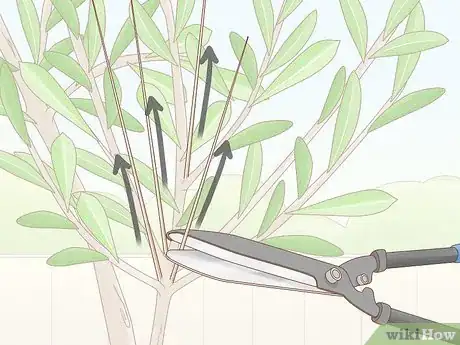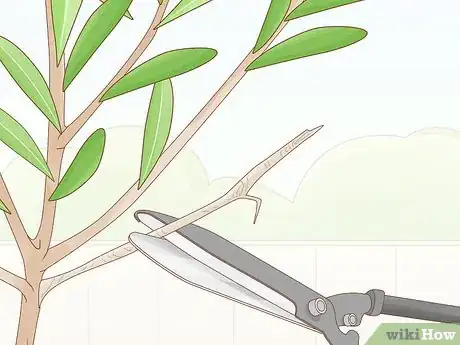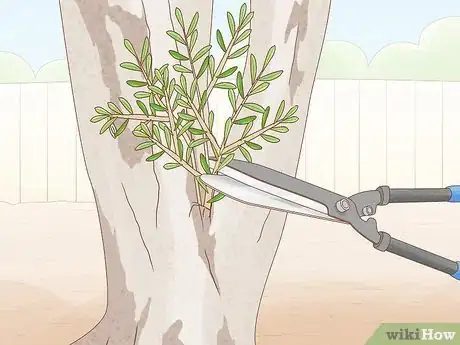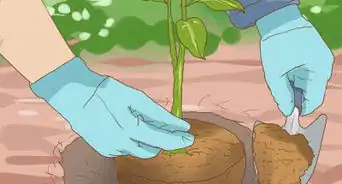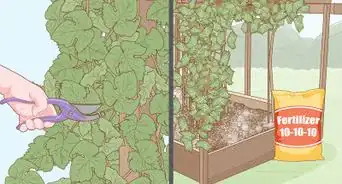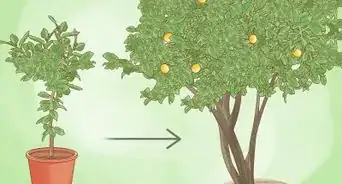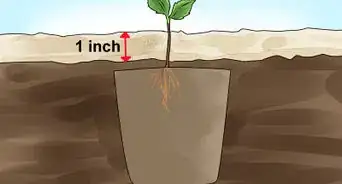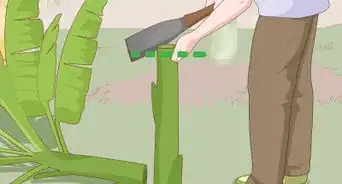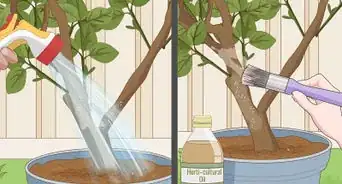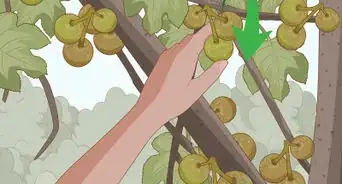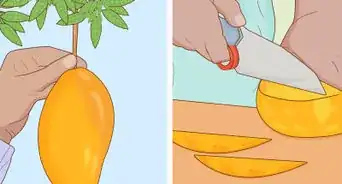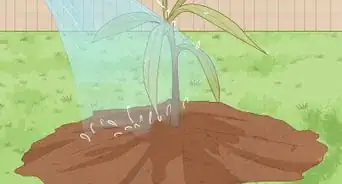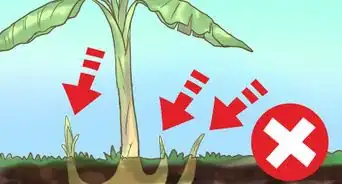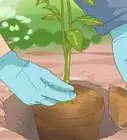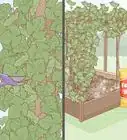This article was co-authored by Maggie Moran. Maggie Moran is a Professional Gardener in Pennsylvania.
wikiHow marks an article as reader-approved once it receives enough positive feedback. In this case, 93% of readers who voted found the article helpful, earning it our reader-approved status.
This article has been viewed 304,489 times.
Olive trees grow slowly and generally require little pruning each year if they are healthy and well-maintained. You will want to begin shaping your olive tree when it’s young, or about 2 years old, and then check it each year in the late spring or early summer for some maintenance pruning. You can look forward to a long fruitful life of 50 years or more with your olive tree with some moderate yearly care.
Steps
Cutting Your Tree with Proper Tools
-
1Have sharp, clean pruning tools. Make sure your pruning shears or saw are both sharp and clean. If they are old and you’re not sure if they are sharp, you can either sharpen them yourself or take them to your local hardware store to have them sharpened for a small fee.[1]
- To clean your shears or saw, dip the blades in isopropyl alcohol for 30 seconds to disinfect them, then carefully wipe them dry with a clean towel.
-
2Use shears for shoots less than 1 inch (2.5 cm) in diameter. Use clean double-bladed shears for your smallest shoots and branches, available at your local hardware store. Consider using shears with shock absorbers to reduce your fatigue while you’re pruning.[2]
- Look for double-bladed gardening shears at your local hardware store.
Advertisement -
3Use a hand saw for branches up to 3 inches (7.6 cm) in diameter. For branches in the densest, internal part of the canopy that are between 1–3 inches (2.5–7.6 cm) in diameter, use a clean hand saw. You will want a saw with a rigid blade that is at least 15 inches (38 cm) in length for the best results.[3]
- 15 in (38 cm) hand saws are available at most hardware stores.
-
4Use a chainsaw with caution for major branches. If you are pruning an old, neglected tree and need to remove large branches, you may need to use a chainsaw. Use a lightweight chainsaw to avoid fatigue and take frequent breaks. Stand on the ground or a stable platform and wear a helmet, goggles, gloves, and heavy-duty clothing.[4]
- Avoid operating a chainsaw if you have any health conditions that cause weakness from physical activity or if the saw is too heavy for you to easily maneuver.
-
5Make slanted cuts that are flush with the branches. Cuts that are slightly slanted will help deter water from soaking into the cut and having your branch get infected. Make cuts that are right against the larger branch that the branch you’re removing is growing from.[5]
- Avoid leaving stubs when you make cuts. Make a clean, slanted cut right up against the larger branch.
Creating Your Olive’s Basic Shape
-
1Begin shaping when your tree is 1 metre (3.3 ft) tall. When your tree is about 2 years old and 1 metre (3.3 ft) tall, with 3 or 4 strong lateral branches, you can begin the first stages of shaping.[6]
- Your tree will not be bearing any fruit until it is about 3 or 4 years old, so this pruning is just to start getting it formed into a shape that will be conducive to healthy growth and fruit bearing.
-
2Prune once a year in the late spring or early summer. When your tree does start bearing fruit, it will be in the fall, so the ideal time to prune is right before it’s about to begin its new growth for the year. Try to prune your tree on a dry day so that the new cuts don’t get too wet and vulnerable to infection.[7]
- Olive trees grow slowly and overall don’t need a lot of pruning. Pruning once per year is plenty.
-
3Avoid cutting too much on young trees. It’s important to maintain a balance between shaping your tree into a form that will be its main structure for life and allowing your tree to grow and build energy reserves. Too much pruning will stunt a young olive tree’s growth.[8]
- If your tree is a few years old and still isn’t 1 metre (3.3 ft) tall with a trunk and more than 3 or 4 strong lateral branches, you can hold off on pruning for another year.
-
4Aim for a martini glass shape. The healthiest olive tree shape is that of a wide martini glass, with the trunk being the glass stem. Most branches should grow laterally and slightly up. The center of the “glass” remains light in branch density to allow light into the center of the tree.[9]
-
5Choose 3 or 4 strong lateral branches to form your main shape. To begin achieving a martini glass shape, choose 3 or 4 strong branches that are growing mostly out and slightly up from the trunk to keep as the main structure for your tree. Leave smaller branches coming off these branches, even if they are growing down.[10]
- You can cut other small, weak, or vertical branches aside from these main 3 or 4.
- If your tree only has 2 strong lateral branches, you can prune others that seem very weak or too vertical, but next year you’ll want to look for another 2 strong branches to keep. Eventually you want your tree to have 4 strong lateral branches for its main structure.
Maintaining Your Olive with Annual Pruning
-
1Observe your tree at picking time. Once your tree is bearing fruit, you will notice that its main lateral branches get weighed down by fruit. These are branches you’ll want to keep at the next pruning time. You will see other branches that are growing vertically, or some that look old or weak.
- Make notes of these vertical, old or weak branches that you should prune the following year.[11]
- Your tree may take a year off from fruiting every other year. Light annual pruning is still a best practice for encouraging new growth.
-
2Remove vertical branches. Branches growing straight up, especially those near the top that are thin and weak, should be removed. You also want the inside of your martini-glass shape to not be dense with vertical branches, so remove those as well.[12]
- A rule of thumb is that a bird should be able to fly through your olive tree. If your tree is too dense with vertical branches in the middle, a bird would not be able to do that, and you should remove more vertical branches.
- Fruit only grows on lateral branches, so another reason to prune these vertical branches is to give your tree more energy to put toward fruit-bearing branches.
-
3Cut lateral branches that have become exhausted and weak. As your tree ages, some of the lateral branches growing off your main branches may become old. When you observed your tree at picking time, these are the old branches that maybe bore fruit at one time, but they have stopped.
- Cut these branches to encourage your tree to grow more fruitful branches.[13]
-
4Remove suckers from the trunk’s base any time. Any growth below the main fork of the tree, going down the trunk to its base, should be removed. These branches are usually small, grow vertically or downward, or otherwise look out of place to your tree’s main shape.[14]
- You can remove these suckers any time of the year, whether its your annual pruning time or not.
Expert Q&A
Did you know you can get expert answers for this article?
Unlock expert answers by supporting wikiHow
-
QuestionWhat do you feed olive trees?
 Maggie MoranMaggie Moran is a Professional Gardener in Pennsylvania.
Maggie MoranMaggie Moran is a Professional Gardener in Pennsylvania.
Home & Garden Specialist
-
QuestionWhy are the leaves falling off my olive tree?
 Maggie MoranMaggie Moran is a Professional Gardener in Pennsylvania.
Maggie MoranMaggie Moran is a Professional Gardener in Pennsylvania.
Home & Garden Specialist
-
QuestionDo olive trees grow in pots?
 Maggie MoranMaggie Moran is a Professional Gardener in Pennsylvania.
Maggie MoranMaggie Moran is a Professional Gardener in Pennsylvania.
Home & Garden Specialist
Warnings
- Be extremely careful with pruning tools and equipment. Wear protective gloves and clothing at all times.⧼thumbs_response⧽
Things You’ll Need
- Sharp clean pruning shears or hand saw
- Chain saw and helmet (optional)
- Safety goggles, gloves, and heavy clothing
- Ladder
References
- ↑ https://modernfarmer.com/2015/02/right-cut/
- ↑ https://www.oliveoilsource.com/page/olive-tree-pruning
- ↑ https://www.oliveoilsource.com/page/olive-tree-pruning
- ↑ https://www.oliveoilsource.com/page/olive-tree-pruning
- ↑ https://modernfarmer.com/2015/02/right-cut/
- ↑ http://www.mediterraneangardensociety.org/olives.html#1
- ↑ https://www.rhs.org.uk/advice/profile?PID=138
- ↑ http://www.mediterraneangardensociety.org/olives.html#1
- ↑ https://www.rhs.org.uk/advice/profile?PID=138
About This Article
To prune an olive tree, choose a time either in late spring or early summer and make sure your tree is at least 3-4 feet tall before pruning. Choose 3-4 strong lateral branches to form your main shape and make slanted cuts to remove branches. Once you've established a shape, be sure to also remove old wood, weak branches, and branches that are growing straight up. Don't forget to remove the suckers growing at the tree's base, too! For tips on choosing the best pruning tools for the job, read on!
